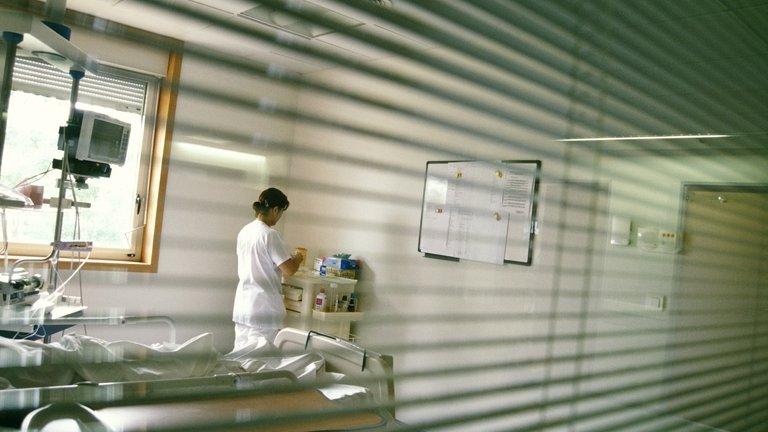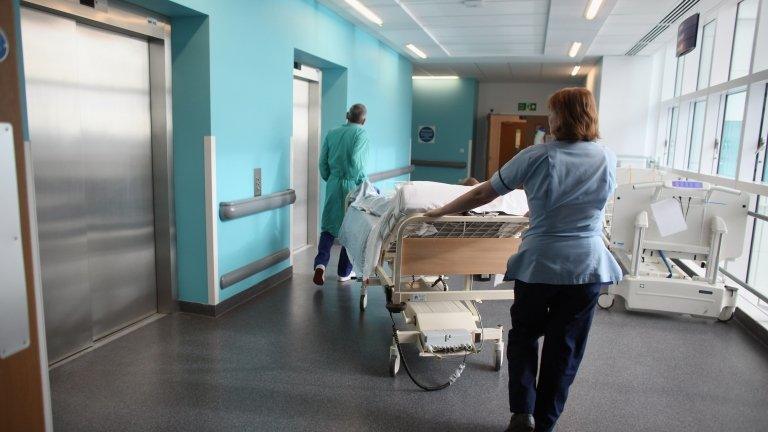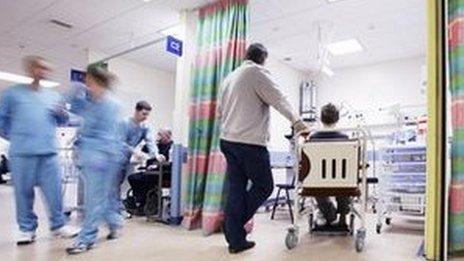Three times as many A&E patients waiting over four hours
- Published
Patients seeking in Scotland's accident and emergency units are waiting longer
The number of patients waiting too long in accident and emergency departments has nearly tripled in five years, according to Audit Scotland.
A report showed 104,000 people waited beyond the four-hour target in 2012-13, compared with about 36,000 in 2008-09.
Health Secretary Alex Neil said the NHS in Scotland was "treating more emergency patients than ever before".
But Labour called for a "full-scale review" of the ability of health services to cope in the future.
The new report from Scotland's public spending watchdog revealed the proportion of people being seen within the four-hour target fell from 97.2% at the end of 2009 to 93.5% by December 2013.
The NHS in Scotland rarely achieved the Scottish government's standard of 98% of patients being seen within the four-hour target over the period studied, according to the report.
Gilbert Bain Hospital in Lerwick, Shetland and the Royal Aberdeen Children's Hospital were the only two to meet the 98% target in each month of the financial year 2012-13, with most other hospitals failing in every month.
The study also discovered a spike in admissions during the last 10 minutes of the four-hour period.
Caroline Gardner, auditor general for Scotland, said: "Delays in A&E can be a sign of pressure across health and social care.
"While there has been improvement in performance, such as the progress made in tackling the longest waits in A&E, performance against the target still remains lower than it was when we last reported."
The issue dominated first minister's questions at Holyrood, with all three opposition party leaders criticising the Scottish government.
Scottish Labour leader Johann Lamont said the First Minister Alex Salmond had promised action on A&E waiting times last year, adding: "Those waiting more than four hours for treatment has tripled on his watch."
She demanded: "When will his actions start to prove effective?"
Mr Salmond said measures already taken, including a £50m emergency care action plan and more staff, that had been welcomed by medics.
He added: "Working together we're going to bring about the sort of improvement that Scotland requires and the patients of Scotland deserve."
Ms Lamont claimed the A&E figures from 2012-13 were the "worst-ever".

Johann Lamont said those waiting more than four hours at A&E had tripled on the first minister's "watch"
But the first minister said the situation had been worse under the last Labour-led Scottish Executive, which Ms Lamont had been a minister in.
Elsewhere, Mr Neil conceded that more needed to be done but highlighted the introduction of the investment plan to improve emergency care.
He said: "The NHS in Scotland is treating more emergency patients than ever before. Our staff are also seeing more patients who are presenting with more serious illnesses.

First Minister Alex Salmond said the £50m emergency care plan had been welcomed by health professionals
"We have already invested heavily - both in service improvements and more staff. That includes the 18 new consultants now appointed across NHS Scotland.
"This builds on the increase under this government, which has seen the number of A&E consultants more than double, from 75.8 to 162.3 since 2006."
Labour MSP Neil Findlay called for a full-scale review of how health and social care services would manage in future.
Scottish Conservative health spokesman Jackson Carlaw MSP said: "In the last five years performance has dipped considerably, and the SNP has to explain why it has allowed this to happen."
Scottish Liberal Democrat health spokesman Jim Hume said: "If health boards are saying that they cannot improve flagging waiting times because of a shortage of staff or beds, the Scottish government must work with them to address this."
Dr Martin McKechnie, consultant of emergency medicine at the Royal Infirmary in Edinburgh, said that while the figures showed that improvement was needed, the government's move to reduce waiting times were starting to provide tangible benefits.
Patient flow
He said: "We have had a lot of support over the past 18 months from the government and we are beginning to see the effects of these. There is a feeling within the specialty that there is a turn within the environment."
Dr McKechnie also felt that improving the procedures of patient "flow" through A&E wards was crucial to reducing waiting times.
"The elephant in the room is patient flow and how to influence systems across the whole NHS to help deal with the unlimited demands being placed on it."
He added: "One of the main issues in patient flow is that over the past five years treating patients 80, 90 and 100-years-old is now the daily norm."
Scotland has 31 A&E departments which saw about 1.35 million patients in 2012-13 at a cost of around £163m, Audit Scotland said.
The report highlighted a variation in demand at A&E departments across Scotland.
The Royal Sick Children's Hospital in Edinburgh recorded an increase of about 15% over the five years whereas demand fell by about 13% at Gilbert Bain Hospital.
- Published3 March 2014

- Published29 January 2014

- Published12 December 2013
